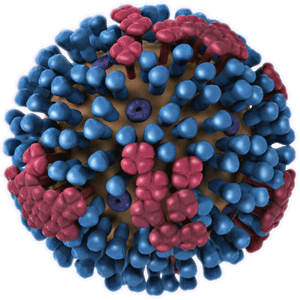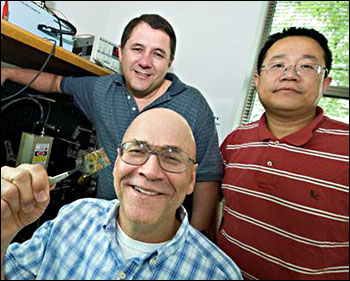
THz Sensor to Detect Viruses Before Outbreaks
DAYTON, Ohio, Sept. 26, 2013 — A new project aims to develop a sensor that uses gigahertz-to-terahertz (GHz-to-THz) radiation to detect viruses captured in nanofluidic chips, with the goal of using the system quickly in places where large, highly mobile groups congregate, such as airports.
There is currently no reliable way to directly detect a virus, which is about 100 times smaller than the average bacterium and too small to be seen directly with an optical microscope. But, under a $625,000 INSPIRE Award from the National Science Foundation, Wright State and Indiana universities, California-based biosensor company Redondo Optics Inc. and the University of Tennessee hope to change that.

A 3-D graphical representation of the biology and structure of a generic influenza virus. Courtesy of the Centers for Disease Control and Prevention, National Center for Immunization and Respiratory Diseases.
“This technology will allow us to detect the presence of viruses like the flu before an outbreak. It will give us predictive capabilities,” said Wright State physics professor Dr. Elliott Brown. “We would be monitoring viruses in near real time.”
Brown, Ohio Research Scholars Endowed Chair in Sensors Physics, is an expert in terahertz radiation, the part of the electromagnetic spectrum higher in frequency than microwave and lower than IR light. He and the team plan to make the first experimental GHz-to-THz measurements of virus signatures. They are working closely with University of Indiana theoretical chemist Peter Ortoleva, who was the first to predict these signatures using advanced computer simulations.
Ortoleva discovered that the capsid shells of certain viruses vibrate resonantly, even in their physiological (aqueous) state. Working with Redondo Optics, Brown then predicted that such vibrations can be detected if the viruses are confined to nanochannels of fluidic chips, similar to the microfluidic chips that are now common in the biological- and chemical-sensor industry.
Brown’s team — which includes postdoc Weidong Zhang and graduate researcher Leamon Viveros — will irradiate the virus shell components in the nanochannels with a beam of GHz-to-THz radiation, revealing an electromagnetic signature and providing a high level of confidence that the signature came from the virus and not some other biochemical.

Physics professor Elliott Brown, Ohio Research Scholars Endowed Chair in Sensors Physics (foreground) and researchers Leamon Viveros (back left) and Weidong Zhang are developing virus-detection technology. Courtesy of Wright State University.
“That is so important because viruses are very difficult to detect,” Brown said. “Also, our technology is capable of detecting these viruses in very small concentrations. This is important is because viruses are known to spread even at very low levels.”
Six years ago, working with Emcore, Brown helped develop the first frequency-domain terahertz spectrometer, which operates with a very high resolution over a very broad tuning range. In the past six months, a compact, more sensitive version has been created that would be easier to deploy to be used in conjunction with the new sensor.
“Ultimately, if we’re going to put these sensors in every airport in the United States, they have to be fieldable and affordable,” Brown said.
Brown’s idea is to sprinkle the tiny nanofluidic chips with samples from an airport’s high-traffic areas, then capture and detect viruses as they first appear using a centralized, on-site spectrometer. The process is also faster than the current gold standard, polymerase chain reaction.
“We’re going to turn back the clock and be able to predict the arrival of the flu weeks ahead of time compared to what we can do today,” he said.
The instrument currently costs about $50,000, but Brown is hoping that new technology and economies of scale will reduce it to below $20,000, making it more affordable for local governments or the Transportation Security Administration (TSA).
“The TSA is in the business of security big-time, and they pay for all kinds of instruments that are there at airports. Why not pay for instruments that monitor human-health threats?” Brown said. “In our thinking, disease is the next big threat that the Department of Homeland Security or the CDC [Centers for Disease Control] needs to watch at airports.”
Brown’s team will first look at the Human Papilloma Virus (HPV) to test the technology. HPV is associated with cervical cancer and has been predicted by Ortoleva to display a signature in the GHz-to-THz region. The team has partnered with vaccine producer GlaxoSmithKline to provide the virus components for testing.
The technology would also prove valuable in that it can be used to optimize vaccine production. In addition, it would also provide clues in immunology by predicting and revealing what parts of the virus are recognized by the immune system.
“This technology has the potential to revolutionize disease detection, vaccine R&D, disease monitoring and outbreaks of all sorts,” Brown said.
The three-year project, which includes an option for an additional $130,000, begins Oct. 1. It is partially funded by the Electronics, Photonics, and Magnetics Devices Program in NSF’s Division of Electrical, Communications and Cyber Systems in the Directorate for Engineering; and the Chemical Structure, Dynamics and Mechanisms program in the Division of Chemistry in the Directorate for Mathematical and Physical Sciences.
Redondo Optics will fabricate, and likely commercialize, the nanofluidic chips.
For more information, visit: www.wright.edu
Published: September 2013